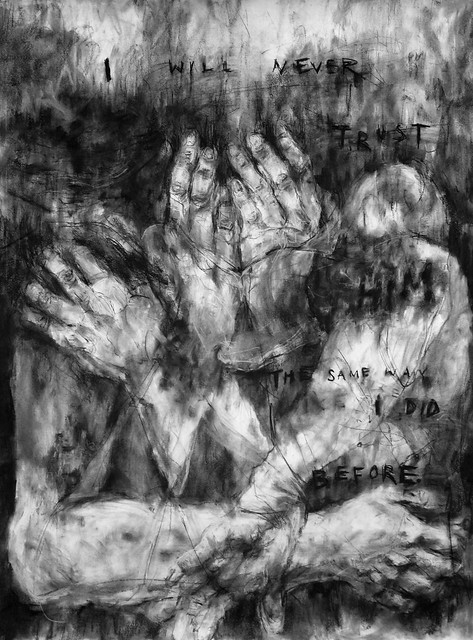Erasers often leave unwanted smudges on drawings. This can be frustrating for artists.
Your eraser might smudge due to several reasons, including the type of paper or eraser used. Sometimes, the pressure applied can also affect the outcome. Understanding why this happens can help improve your art. Artists rely on erasers for clean corrections.
But not all erasers work the same. Different materials in erasers interact with paper in various ways. Some erasers are too soft, leaving behind residues. Others are too hard, tearing the paper. The paper’s texture also plays a role. Smooth paper might smudge more than rough paper. Knowing these factors can help you choose better tools. This knowledge will help you maintain the clarity of your drawings. Let’s explore why this happens and how to prevent it.
Common Causes Of Smudging
Smudging is a common issue for artists and hobbyists alike. It can ruin the clean lines and details of a drawing. Understanding why your eraser smudges can help you avoid this problem. Several factors contribute to smudging, which are often overlooked. Recognizing these can lead to better drawing experiences.
Type Of Eraser Used
The type of eraser matters. Different erasers have different compositions. Some are harder and some are softer. Softer erasers might leave residue behind. This residue can smudge your drawing. Vinyl erasers tend to smudge less. They are firm and remove graphite efficiently. Kneaded erasers mold to any shape. This flexibility is great for precision. Hard erasers sometimes damage the paper. They can smear graphite if too much pressure is applied.
Paper Texture And Quality
Paper texture plays a key role. Rough paper tends to hold graphite more. This makes it harder to erase without smudging. Smooth paper allows for cleaner erasing. Yet, it can smear if the eraser is too soft. Paper quality affects drawing integrity. High-quality paper resists damage and smudging. Low-quality paper may tear or smudge easily. Choose paper with the right texture for your art style. Consider testing different types to find the best match.

Impact Of Pencil Lead
Ever noticed how your eraser smudges your drawing instead of cleaning it? The pencil lead’s impact can be significant. Understanding the pencil lead helps in creating cleaner drawings.
Graphite Composition
Pencils contain graphite mixed with clay. This mixture affects how the pencil marks behave. Softer pencils have more graphite. They produce darker marks. These marks are prone to smudging. Harder pencils have more clay. They create lighter marks, reducing smudging risk.
Choosing the right pencil is crucial. For detailed work, use harder pencils. They offer cleaner lines. For shading, softer pencils work well. But be cautious about smudging.
Pressure Applied While Drawing
Pressure affects how pencil marks interact with erasers. Pressing hard embeds graphite deeper into the paper. This makes erasing difficult. Lighter pressure leaves marks on the surface. Easier to erase.
Control your drawing pressure. Practice to find the right balance. This reduces smudges and keeps your artwork clean.
Techniques To Minimize Smudging
Smudging is a common frustration for artists, especially when you’re trying to achieve a clean and precise look in your drawing. Thankfully, there are effective techniques to minimize those annoying smudges. Understanding these methods can make your drawing experience smoother and more enjoyable. Let’s dive into some practical solutions that can keep your artwork looking sharp.
Proper Erasing Methods
Using the right erasing technique can significantly reduce smudging. Start by gently tapping the eraser on the area you want to lighten. This lifts the graphite without spreading it across your paper.
Another method is to use a kneaded eraser. Shape it into a point or wedge for precision. Press and lift gently to remove marks without smearing.
Avoid long, sweeping motions with your eraser. These can spread the graphite and create unwanted smudges. Instead, focus on short, controlled strokes to keep your drawing intact.
Using A Light Touch
Applying a light touch when drawing and erasing can be a game changer. The harder you press, the more graphite is pushed into the paper, making it tougher to erase cleanly.
Start by using softer pencils. These require less pressure and are easier to erase. Experiment with different pencil grades to find the perfect balance for your style.
Consider your own experience. Have you ever noticed how a lighter touch maintains the paper’s texture? This simple adjustment can make your erasing more effective.
Think about how you can integrate these techniques into your drawing routine. What changes can you make today to enhance your artwork? With a bit of practice, you’ll find these methods become second nature.
Choosing The Right Eraser
Choosing the right eraser can transform your drawing experience. Many artists face frustration with smudges and residue left behind by erasers. Understanding the different types of erasers helps in selecting the perfect one for your needs. This section explores various erasers and identifies the best options for artists.
Different Eraser Types
Erasers come in various forms and materials. Each type serves a distinct purpose. Rubber erasers are common and versatile. They are effective for most pencils but can be harsh. Vinyl erasers offer a smoother experience. They remove marks without damaging the paper. Kneaded erasers are adaptable and can be molded. They lift graphite gently without leaving crumbs. Gum erasers are soft and crumby. Perfect for delicate paper surfaces.
Best Erasers For Artists
Artists need precision and control. Kneaded erasers are ideal for detailed work. They allow artists to lighten specific areas without smudging. Vinyl erasers are also popular among artists. They erase cleanly and maintain the integrity of the artwork. For large areas, consider using a rubber eraser. It clears marks quickly and effectively. Always test the eraser on a small section first. Ensure it suits your drawing style and paper.
Correct Paper Selection
Choosing the right paper is essential for clean drawings. The paper’s surface can affect how your eraser interacts with your artwork. Using the wrong type of paper can lead to smudging. This can ruin your hard work. Let’s explore the elements of correct paper selection.
Surface Finish Options
Paper has different surface finishes. Smooth paper is great for fine detail. But it can cause smudging with some erasers. Textured paper, like cold-pressed, offers more grip. This can reduce smudging. Each finish gives a different effect. Testing papers helps find your perfect match.
Paper Weight Considerations
Paper weight affects erasing results. Heavier paper, like 200gsm, handles erasing well. It is less prone to tearing. Lighter paper can tear easily under pressure. This makes smudging more likely. Always check the paper weight before starting a drawing. It can save you from frustration.
Protective Measures For Artwork
Preserving artwork requires skill and knowledge. Artists often face challenges with smudging. It’s common with erasers, leaving unwanted marks. Understanding protective measures can save your art. These techniques help maintain clarity and detail.
Using Fixatives
Fixatives are sprays that secure pencil marks. They prevent smudging effectively. Apply evenly over your drawing. Choose a non-yellowing fixative for longevity. Use in a well-ventilated area. Protects both graphite and charcoal. Test on a small section first.
Layering Techniques
Layering improves durability of drawings. Start with light pencil strokes. Gradually darken layers with pressure. This reduces smudging risks. Use a protective sheet while working. Helps keep layers intact. Consider using different pencil grades.
Tips For Clean Erasing
Many artists face the frustrating problem of erasers smudging their drawings. Clean erasing can be a challenge, but with the right techniques, it becomes easier. Here, you’ll find helpful tips to keep your artwork spotless.
Maintaining Eraser Cleanliness
Ensure your eraser is free from dirt and pencil residue. Dirty erasers often cause smudges. Regularly clean your eraser by rubbing it on scrap paper. This removes built-up graphite and dirt. Keep your eraser in a case or pouch. This prevents it from picking up dust.
Avoiding Excessive Pressure
Pressing too hard while erasing can damage your paper. It can also create smudges. Use light, gentle strokes with the eraser. This reduces the risk of tearing the paper. It also keeps your lines sharp and clean.

Advanced Techniques For Artists
Artists often face challenges with erasers smudging their drawings. Using erasers creatively can help improve art. Understanding advanced techniques makes a difference. These techniques allow for better control and expression. Artists can enhance their work significantly.
Using Erasers Creatively
Erasers can do more than correct mistakes. They can shape and refine drawings. Artists use them to create highlights and textures. Soft erasers can lighten areas smoothly. Hard erasers define sharp edges. Try using an eraser as a drawing tool. Draw with it on a dark surface. This technique adds depth and dimension.
Combining Erasers With Other Tools
Erasers work well with different tools. Pair them with charcoal or graphite. This combination offers interesting effects. Use erasers alongside blending stumps. This helps in softening lines. Mixing techniques can enhance the final piece. It provides a unique texture and feel.

Frequently Asked Questions
How To Stop An Eraser From Smudging?
To prevent eraser smudging, use a clean, high-quality eraser. Apply gentle pressure while erasing and ensure your paper is dry. Keep your eraser free from pencil residue by wiping it regularly. Use a kneaded eraser for delicate areas to avoid smudges.
Store erasers in a cool, dry place.
How Do I Stop My Drawings From Smudging?
Use fixative spray to seal your drawings. Choose smudge-resistant paper and avoid touching the artwork. Place a paper under your hand while drawing. Store drawings in protective sleeves or folders.
Why Do Erasers Smear?
Erasers smear because they are made of soft rubber that grips paper fibers. Applying too much pressure can cause the eraser to break down and leave residue. Using the wrong type of eraser for specific pencil marks can also lead to smearing.
Choosing the right eraser and using gentle strokes can prevent this issue.
How To Erase A Pencil Without Smudging?
Use a quality eraser and apply light pressure. Hold the paper steady to prevent movement. Erase in a single direction to avoid smudging. Clean the eraser before use for best results.
Conclusion
Understanding why erasers smudge can improve your drawing skills. Choosing the right eraser is crucial. Test different types to find what works. Keep your drawings clean by using light pressure. Store your erasers properly to avoid dirt. Always maintain your sketching tools in good condition.
These tips help reduce smudging and keep your art neat. Practice and patience make a difference. Experiment with techniques to find the best results. Happy drawing! Your skills will grow with time and care. Embrace the learning process and enjoy creating art.














